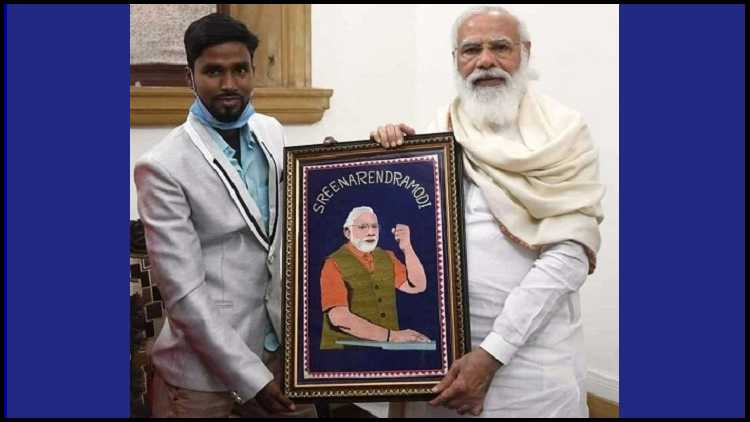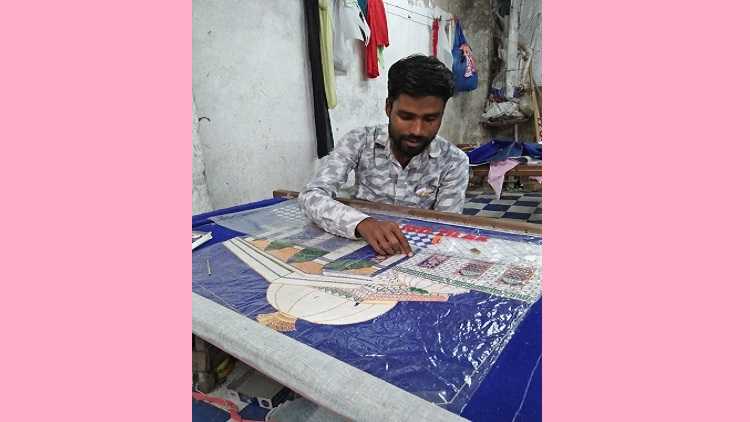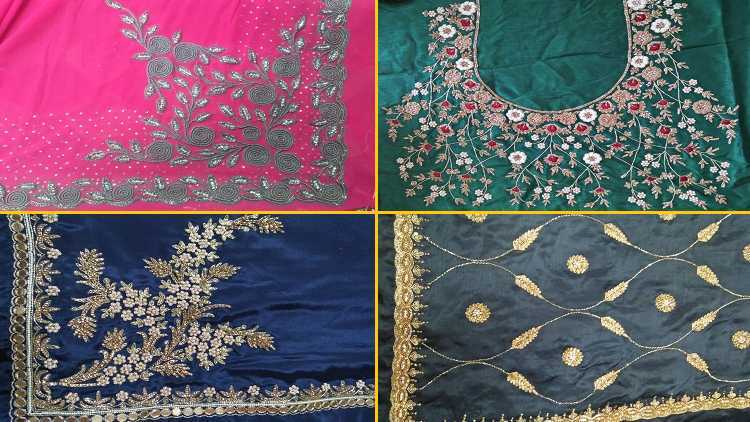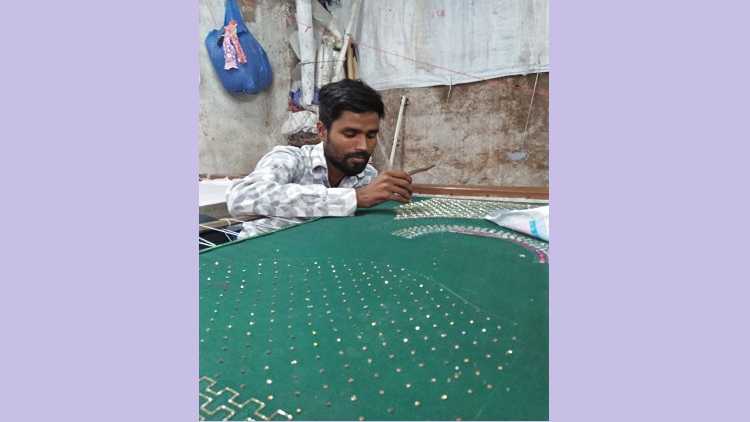
Baishali Adak/New Delhi
The ‘Parakram Diwas’ event at Kolkata’s Victoria Memorial Hall on January 23rd made headlines for CM Mamata Banerjee walking out of it over chants of ‘Jai Sree Ram’ by some in the audience. However, a smaller yet significant incident here went unnoticed by everyone.
A 27-year-old Muslim artisan, Jahangir Mollah, fulfilled his life’s dream by presenting a ‘Zari portrait’ of Prime Minister Narendra Modi to the man himself!
After Modi had delivered his speech on the occasion of Netaji Subhash Chandra Bose’s 125th birth anniversary, Mollah met him backstage at the Ministry of Culture programme.
The resident of Panchla in Howrah, a known hub of skilled Zardozi artisans, handed over to the PM a golden-framed 2 feet long and 1 feet wide portrait -- an accurate depiction of the BJP strongman in a saffron shirt, green sleeveless jacket and his fist clenched in iron determination.
It took Mollah seven long months to stitch this portrait, a time few Zari artisans can afford due to their poor financial circumstances. And more importantly, he captioned it ‘Sree Narendra Modi.’ Among Bengalis, Sree is used to prefix names of Hindu Gods and Goddesses like Ganesh and Lakshmi as a mark of respect, unlike Shri, which is used for ordinary humans.

Jahangir working on a zari portrait of Taj Mahal. Zari embroidery is of many kinds, the one in which portraits are done uses 'Needle no.10.'
I could only keep staring at him: Mollah
“Honestly, I could only keep staring at him,” gushed the young man recalling the incident. “Modi ji asked me in Hindi, ‘Kitna samay laga ise karne mein? Ye kaam to Surat mein bhi hota hai na?’" (How much time did it take to make this? Isn’t this embroidery work done in Gujarat’s Surat city as well?)
"I was too lost for words and could only say, ‘Yes,’ to which he replied, ‘Very beautiful. Stay well,’” Mollah remembered the brief meeting.
Besides immense respect for the PM, Mollah said an important reason why he wanted to meet Modi was to draw his attention towards the “pathetic condition of Zardozi artisans.”
Zardozi is an ancient Indian form of embroidery which uses metal fibre (beaten gold, silver, copper or slitted polyester wires) to give an embellished and rich look to garments. Its current form in India is believed to have come from Persia in 1700-1100 BC.
There are about 6 crore Zardozi artisans across the country in areas like Lucknow, Hyderabad, Mumbai, etc., and 15 lakh of those are in West Bengal. Of these, 5 lakh reside in Howrah alone in areas like Panchla, Amta and Domjur. While some of these are Hindu, majority are Muslim.

Zari embroidery is done on all types of Indian garments like saris, suits, lehengas and sherwanis
 Middlemen & computer embroidery ruin the art
Middlemen & computer embroidery ruin the art
Mollah said Zari artisans have been completely handicapped by the lack of open markets and predominance of ustaads/mahajans.
"These middlemen take big orders of saaris from wholesale markets like Burrabazar and Metiabruz and distribute them among us for embroidery after deducting a hefty margin. We are paid just Rs. 1400-1500 for designs that take two weeks to complete. Who can run a household with just Rs. 100-150 a day?” Mollah asked.
Another problem, Zardozi workers say, is the advent of computer embroidery. New technology does zari designs on clothes with precision in just 10 minutes, as opposed to the hours taken by a human. This has led to both the demand and market price for Zari workers falling. On the other hand, the cost of zari material (resham fibre, sequins, beads and spangles) is only going up.
“Besides, after doing this for 12-13 hours per day, one’s eyesight gets weak by the age of just 35. Once the ustaad sees you in specs, your rate as a Zari worker comes down automatically. Due to the awkward postures we work in, the neck and spine go for a toss, and after 60, you become completely blind,” Hasan Molick, Howrah Jala Zari Union President said.
“No one from our younger generation is willing to take this up. The boys in our locality are willing to work at cycle puncture shops, at construction sites or even jute mills, but not learn this. This craft will die out in just years,” a worried Hasan added.

Since contractors can't afford the rent of factory spaces anymore, Zari artisans like Jahangir work from their tiny one-room homes
We don’t want alms, only assistance: Zari workers
The zari workers said they have approached several authorities and departments for a remedy to this situation, but to no avail.
“We have been struggling to highlight our problem for the past 13-14 years now. Sometime in 2012, the-then Textile Minister of Bengal, Manas Bhunia, promised to get us ID cards for direct cash transfers or PF/pension, and the same has been done for 1.7 lakh zari artisans already. However, we have received no money; we are just going around with the useless IDs in our pockets,” said SK Younus, Bengal Secretary, Sara Bharat Zari Shilpi Kalyan Samiti.
“We don’t need government dole outs in the form of Rs. 2 per kilo rice and Rs. 3 per kilo wheat. We are artists, please provide us a market for our craft, and we will be able to lead a life of dignity,” Younus added.
‘Atmanirbhar Bharat may help them’
The founder-director of an NGO, which has been helping Zari workers through the COVID lockdown and Amphan cyclone, said this community needs help urgently.
“At our level, we have been providing them foodgrains, sewing machines and tarpaulins (to cover hut roofs). We have been training them to do zari work not just on saaris, but also curtains and cushion covers which are more in demand. Besides, we are working on a programme called ‘From Mangla Haat to Walmart.’ This means that we will take their products from their local Tuesday market to even Walmart,” said Anushree Mukherjee of the NGO Suchetna.
“However, more government help is always welcome. For example, if they could be provided some assistance under Atmanirbhar Bharat, that would be great. The young ones like Jahangir are very enterprising,” she added.
